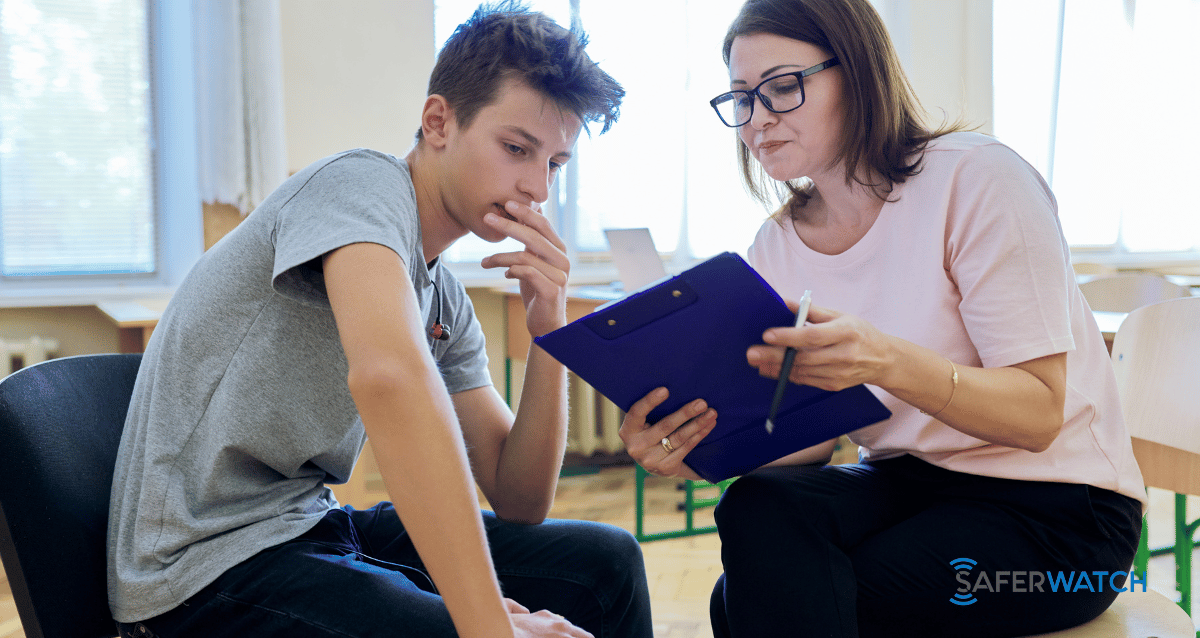What does Student Mental Health Look Like in 2024

Since the pandemic, mental health has become increasingly important to schools and parents as they try their best to ensure students’ well-being. Are you ready? We will be discussing up-to-date statistics on students’ mental health in 2023 and how academic stress affects it negatively, with technology playing a part, too. There are numerous initiatives set by educators meant to offer support plus resources aimed at helping fight off challenges faced due to lack of proper care regarding this matter.
Key Takeaways
- 2023 statistics reveal concerning mental health issues among youth, especially those in marginalized groups.
- The COVID-19 pandemic has caused a disruption of support systems and services in schools, leading to increased stress, anxiety and depression.
- Schools must prioritize professional development for staff with appropriate training and resources to address student mental health needs.
Mental Health in Schools Statistics 2023
Recently, it has been determined that a mental health crisis exists and is worsening. The US Surgeon General highlighted the need for increased psychological support due to challenges posed by Covid-19. Over one in three high school students have experienced low emotional well-being during this period of time, according to research from CDC’s Youth Risk Behavior Surveillance System, which disclosed an uptick of 40% regarding persistent sadness, hopelessness, plus thoughts and behaviors related to suicide across young people before pandemic occurred [1].
Variances with regard to access to psychosocial treatment are observed between different minority demographics, such as African Americans or LGBT youth who experience racism too often, resulting in worsened mental well-being amid the global situation we face in the present day.
Those conditions affect many aspects, including energy levels, reliability, and concentration, also reducing their academic success rates. Long-term negative repercussions can potentially lead them even quit education if all necessary attention isn’t provided on time, either through personal professional help or wider community assistance.
Negative consequences caused by depression and stress include but are not limited to, a significant GPA decline. This causes alarming issues among student bodies, making it essential for schools to join forces around these matters, promoting optimal psychological states amongst future generations and taking into account social diversity surrounding the same problem.
Impact of COVID-19 on students’ mental health
During the COVID-19 pandemic, schools were drastically affected by closures and virtual learning, which had limited access to necessary support services. This had a serious negative effect on mental health among youth due to difficulty with school work, emotional abuse at home, physical abuse, or lack of food. Stressful events like these caused anxiety levels amongst students to be higher than usual, as well as increased depression rates for those struggling without adequate support in place during the pandemic.
It is clear that gaps exist when it comes to providing sufficient mental health care for children and adolescents (approximately 80 percent are not receiving such services despite needing them), meaning that interventions from educational settings become more crucial within this context if we want our kids’ psychological wellbeing addressed properly.
Mental health disparities among different demographics
Mental health issues were more prevalent among certain demographic groups during the pandemic, such as LGBTQ+ youth and those who have experienced racism. This is mainly due to things like racial disparities in access to mental health care and socioeconomic differences, which cause various ethnic minorities to suffer more significantly from poor mental well-being. To support all students sufficiently, it’s key that schools, communities, and policymakers collaborate together in order to create an environment where everyone can be provided with the necessary assistance no matter their identity or background.
There are safety checklists to follow to ensure a safer and more welcome environment now that kids and teenagers are back at school.
The Role of Schools in Addressing Mental Health Concerns
Schools have a fundamental role in addressing mental health matters; Many lack sufficient resources and training for educators to provide adequate support. Educators are instrumental during the course of a student’s academic career as they can closely monitor their social and educational progress while recognizing any signs or indicators of emotional distress. Availability of mental health services at schools is inconsistent, with some not having enough means available to effectively look after students’ psychological needs.
Adults and companions within an academic environment can alter young people’s state of mind through school connectedness. How much attention, care, and enthusiasm is given towards helping them succeed in life plays a huge part in maintaining healthy well-being among individuals of this age group.
There are studies showing that those who experienced feeling supported during middle/high school years were unlikely to suffer from substance abuse problems or issues concerning suicide and sexual behaviors later on down the line.
Also, being able to build meaningful relationships early in life gives lifelong benefits, which can be demonstrated by adults today who continue to display positive impacts due to these connections formed before adulthood.
For instance, we can also mention that schools play a pivotal role in preventing school shootings by creating a supportive environment that fosters a positive school climate and ensures students feel safe and cared for. They can also designate behavior threat assessment and management teams to identify students who may pose a risk and take appropriate action.
Involving students in the adoption of school safety and security plans is crucial as they often have valuable insights into the dynamics of their school community. Schools can also implement various safety measures, such as hiring armed security officers, restricting access to campus buildings, installing metal detectors, and training individuals on how to respond when a shooter enters school grounds. Collaboration with healthcare providers can help in identifying young patients at risk.
Furthermore, old buildings can be retrofitted for school safety technology. Thus, prevention efforts by teachers, administrators, parents, community members, and even students can reduce violence and improve the school environment.
Mental health services availability in schools
Mental health services are essential in schools, yet only about half of the surveyed institutions feel prepared to manage emotional issues among their pupils. To improve student well-being and create a secure learning atmosphere, it is key for school districts to collaborate with community members, government entities as well as mental health specialists so that students can access available resources and support they need.
Services may comprise psychotherapy treatments. Medication management or counseling from faculty staff who work on developing positive schoolwide wellness promotion activities. There could be variations between different schools regarding these types of service accessibility.
Training and support for educators
Schools must take responsibility and invest in the professional development of their educators, equipping them with appropriate training to identify signs of mental health distress among students. Doing so empowers staff members to provide effective interventions for issues like trauma, behavior or attention problems, depression, and anxiety in children. To ensure all professionals working with minors are properly prepared, The Evidence-Based Treatment Dissemination Center – a state-funded agency, offers free evidence-based practice courses for these matters. Thus creating more inclusive spaces within schools that appropriately address student’s mental health needs.
Health articles for students in 2023
Students, educators, and parents in 2023 addressed a range of topics regarding health. These include ways to improve mental well-being, the connection between physical and mental health, treatments for childhood cancer diseases, as well as exploring the importance of having healthy diets.
Articles like these aim to heighten awareness about how important it is for there to be support available within schools when it comes to addressing any form of psychological concerns students may have. They offer valuable advice along with resources that can help contribute towards making an environment where everyone feels more secure and accepted than ever before.
Here are some health articles from 2023 that might be interesting for students:
- Kids’ mental health is in crisis. Here’s what psychologists are doing to help: This article discusses the mental health crisis among children and teens, especially in the context of the Covid-19 pandemic. It explores the various challenges faced by youth and the efforts psychologists are making to help.
- Teen Health News by ScienceDaily: This source provides a variety of articles on teen health, including topics like sleep-wake therapy for depression, the benefits and risks of state-mandated school-based BMI assessments, and the impact of attractiveness and athleticism on middle school experiences.
- Child & Teen Health Articles by Harvard Health: This page contains a collection of articles on child and teen health, mental illness, physical health, and more from Harvard Health.
Strategies for Improving Mental Health in Schools
The enhancement of mental health strategies in educational institutions is an essential part of promoting the success and welfare of all learners. Early detection, intervention, as well as creating a hospitable yet secure atmosphere are key components that contribute to constructing a comprehensive method for taking care of psychological issues experienced by students at school.
In this piece, we will take one step into these tactics and examine how they can be implemented properly throughout schools nationwide.
Early identification and intervention
Schools must focus on early detection of mental health issues in order to improve overall well-being and combat serious conditions that often develop by the age of 24. To ensure a secure, supportive environment for students suffering from related problems, they require access to resources as well as adequate education and support among educators who are able to identify concerns arising with young people’s mental health. It is crucial that schools make sure such skill sets can be applied to any illnesses that may be detected quickly and efficiently, ultimately providing relief for those affected.
Creating a safe and supportive environment
Research suggests that creating a positive learning environment in schools is essential for students’ mental health and general well-being. Strategies to promote school connectedness include improved classroom management, service-learning programs with mentors from the community, as well as providing greater security and acceptance of LGBTQ+ youth. Schools can support their students by developing anti-bullying policies, reinforcing inclusion practices, and offering more comprehensive education on mental health topics both inside classrooms but also within families. If these measures are implemented effectively, it could lead to better psychological stability among pupils overall.
The Connection Between Academic Stress and Mental Health
Academic pressure can be extremely trying for college students, leading to an array of mental health issues. Bullying and a lack of help could bring forth feelings ranging from depression to anxiety in pupils. The introduction of technology into education has created fresh difficulties that add stress on individuals as they have got strive through sophisticated digital learning atmospheres.
This section will evaluate how academic tension is linked with psychological well-being and analyze how technological advancements affect learners’ capacity to manage their distress levels more effectively.
Does school affect mental health?
Students’ mental health can be deeply impacted by school, often due to bullying, heightened academic stress, and restricted educational avenues. Research has shown that when students are overwhelmed with pressure in the classroom, it leads to a drop in their overall well-being, an uptick in anxiety or depression disorders, and a dip in lower academic performance levels. Complications like repeating grades frequently occur for those who have not had adequate help managing mental health issues, which may lead them as far as dropping out altogether.
It is pivotal that schools recognize these concerns surrounding students’ psychological well-being so they effectively address these risks through providing safety measures along with applicable resources/interventions, allowing access to improved support systems promoting betterment amongst all learners coupled with enhanced success achieved academically, too.
Effects of technology on academic stress
Schools must be aware of the pressure technology can cause on students’ mental health and academic stress. By providing assistance, resources, and knowledge to handle digital learning appropriately. Institutions have a responsibility to equip learners with the essential capabilities for facing challenges in today’s day and age. Mental well-being should not become disrupted by high demands such as multitasking or technological difficulties due to inadequate help from teachers/advisers, etc. The school has a duty to help pupils build their resilience, which will prepare them to endure any form of educational strain brought about by modern advancements.
Strategies for managing academic stress
Students must take active steps to manage their academic stress in order to maintain good mental health and well-being. Strategies such as setting boundaries, getting support from people they trust like teachers or family members, and investing time into self-care activities can be particularly useful for tackling the challenges of academia while looking after one’s mental state.
Boundaries should include prioritizing study sessions with breaks in between, along with achievable goals. This will help ensure that students don’t overextend themselves beyond what is reasonable. Seeking out trusted individuals provides the assistance needed by some pupils dealing with stressful situations, academically related or not. Doing so brings comfort, which promotes better decision-making overall when facing obstacles head-on during educational pursuits.
The incorporation of enjoyable activities allowing relaxation also plays an essential role: going outdoors, reading books outside assigned course work, plus connecting socially are a few ways to keep focused whilst allowing mind ‘breathers’.
Access to Mental Health Resources and Treatment
In order to provide students with the mental health care they need, there is a need for more consistent access and equitable systems of care across states. A study revealed disparities between levels of availability in terms of insurance coverage as well as prevalence rates when it comes to mental illnesses among youth. This points towards an urgent call for comprehensive solutions so that all have equal chances of accessing these resources.
Insurance coverage and mental health care
It is essential that policymakers address the lack of mental health coverage for youth who have private insurance, as this can impede their access to resources and support necessary for proper care. Approximately 10% of young individuals with individual plans are not covered when it comes to emotional or psychological issues. All Marketplace insurance includes these types of services among its benefits, but Medicaid and Medicare also provide help in terms of covering certain costs related to mental health treatment [2].
Key points must be considered: all students should have availability regardless of their plan type; scope may vary between companies; knowledge about disparities linked with gaps in protection will contribute to reducing them even further; all members ought to gain accessible assistance if needed. Considering such facts helps us understand why it’s important for authorities to take action to guarantee each student receives enough aid no matter what kind of policy they own.
State-by-state analysis of mental health resources
Investigations into the availability of mental health resources at a state level have revealed inequalities in access to care and the occurrence of psychological issues among young people. In South Carolina, 59.8% of teens with severe depression had not received any assistance regarding their condition in 2023 [3]. On the other hand, states such as Massachusetts, Oregon, Delaware, Maine, Vermont, Alaska, and Rhode Island are considered to have made greater investments toward comprehensive mental health services compared to others.
Knowledge about these disparities can help shape policy decisions that allot more sources effectively so that all students receive adequate attention for their psychiatric needs. By addressing this problem and increasing financial support towards providing better quality mental healthcare it will enable youth fulfillment academically plus enhanced personal growth overall on behalf of children’s well-being.
Initiatives and Programs Supporting Students’ Mental Health
Various government and community initiatives are aiming to promote mental health among students. Strategies include making policy recommendations, forming partnerships, boosting accessibility of healthcare services related to mental health, training educators on supporting the well-being of their pupils as well and creating safe atmospheres in educational institutions. All these elements serve an important purpose: improving student’s overall well-being and mental state while helping them better cope with life challenges during this critical phase in their lives.
Government efforts and policy recommendations
The U.S. Surgeon General and other pertinent governmental departments are proposing Initiatives to address the growing mental health issues among students in schools across America, including increased access to related services, training for school personnel with regard to assisting those affected, plus fostering an atmosphere of security as well as support within educational settings. If effective implementation is ensured by way of policy decisions that prioritize mental well-being and allocate sufficient resources accordingly, it will be possible for children to obtain better emotional welfare, both academically and personally speaking.
Community-based programs and partnerships
Organizations like NAMI, AFSP, and The Child Mind Institute strive to reduce the stigma surrounding mental health by offering resources that help students as well as educators better comprehend problems associated with this field. It is essential for schools, in conjunction with these organizations and government agencies, to collaborate on creating an atmosphere where everyone’s mental health concerns can be addressed through support and inclusion. This way of working will provide those involved access to necessary supplies which are needed when handling issues regarding children’s psychological well-being.
SaferWatch and School Safety
Creating and maintaining a secure environment in schools is of utmost importance to foster the mental well-being of students as they learn. It’s essential that students have an atmosphere that supports their growth without fear, so instituting solid safety measures with help from community partners will provide just this. Mental health and education are closely intertwined. By providing such security for pupils it allows them to focus on learning while feeling protected, making sure both their psychological needs and educational goals can be met simultaneously.
The SaferWatch app is a web and mobile-based security system that offers several features, such as incident management, mass notification systems, mobile panic alert systems, threat assessment, and tip and threat reporting.
It’s designed to enhance security for various organizations, schools, events, neighborhoods, places of worship, and more, and those interested can request a demo online.
Full Summary
The mental health and well-being of students are critically important, necessitating cooperation between schools, the community, and policymakers. To ensure success in both life satisfaction and academics for our youth, we must gain an understanding of current student mental health issues as well as any contributing factors.
Following this knowledge-gathering process, steps should be taken to provide necessary support systems along with resources so that a welcoming learning atmosphere can develop for all learners. The importance of young people’s psychological welfare cannot be understated. Focusing on it is imperative if they are going to achieve their highest potential.
Frequently Asked Questions
What percentage of students have mental health issues in 2023?
In 2023, the top stressor among college students was identified to be mental health-related issues by a survey from virtual health services provider TimelyMD. It revealed that 71% of these students had issues like depression, anxiety, and/or stress, while 50% disclosed this as their major problem [3].
How can schools play a role in addressing mental health concerns?
Schools have a duty to support their students, specifically in terms of mental health. This can be done by providing access to services and resources devoted towards this purpose as well as educating educators on how best they can
How does academic stress affect students’ mental health?
The mental health of students can be negatively impacted by academic stress, resulting in a decrease in their overall well-being and an increase in both anxiety and depression, as well as poor performance at school.





























